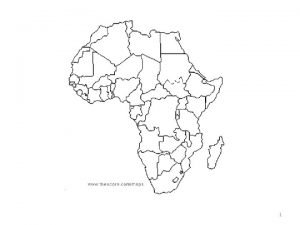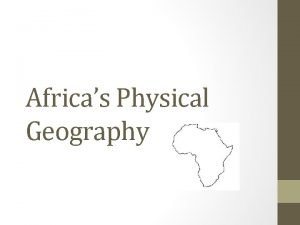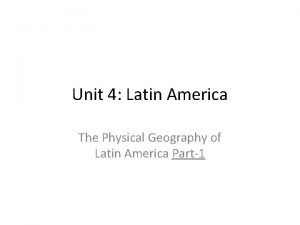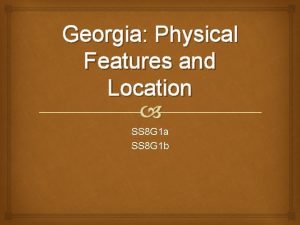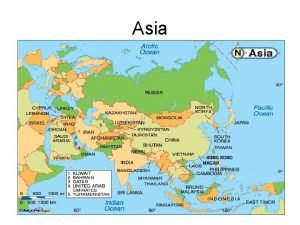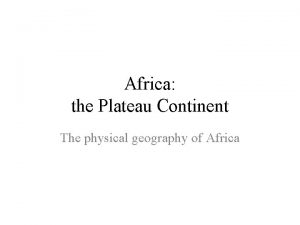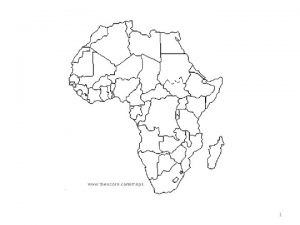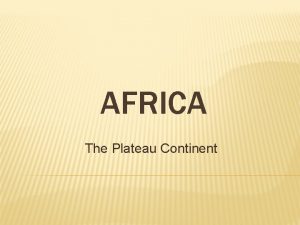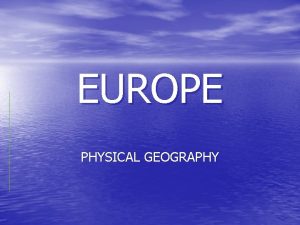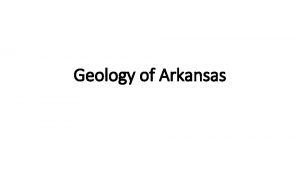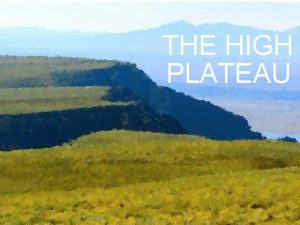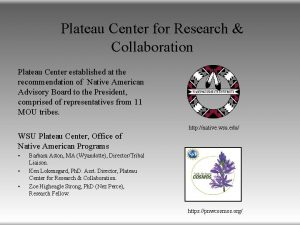Africas Physical Geography The Plateau Continent Most of











- Slides: 11

Africa’s Physical Geography

The “Plateau” Continent • Most of Africa’s land is raised and level

Africa’s 4 Regions • North • Most well known for the largest desert in the world- Sahara • Rocky Mountains located in the Northwest • Sahel- Region below the Sahara • and above the grasslands of • the west

Africa’s 4 Regions • West • The most populated region of Africa • Has good farm land • Made up of mostly savanna and rainforest

Africa’s 4 Regions • East • The most elevated region of Africa • The Great Rift Valley- created by plate movement, stretches 4, 000 miles • Ethiopian Highlands, Serengeti Plain and Mt. Kilimanjaro (tallest in Africa) located here

Africa’s 4 Regions • South/Central • Very diverse region • Congo Region is home to an important river and rainforest • Below the Congo is a stretch of savanna home to a variety of wildlife • The South is made up of grasslands, the Kalahari and Namib deserts, and mountains

3 Main Vegetation Regions • Desert • Some scrub and small bushes, gravel, rocks, and sand dunes • Tropical Savanna • Most common vegetation in Africa • Grasses, bushes, scattered trees • Wet and Dry season • Tropical Rainforest • Diverse groups of plants, trees, and animals

Africa’s Major Rivers • Nile • The Nile is about 4, 160 miles in length and is the longest river in Africa and in the world. Although it is generally associated with Egypt, only 22% of the Nile’s course runs through Egypt. • In Egypt, the Nile creates a fertile green valley across the desert. It was by the banks of the river that one of the oldest civilizations in the world began. The ancient Egyptians lived and farmed along the Nile, using the soil to produce food for themselves and their animals. • 2 x the Mississippi • Flows North from Lake Victoria

Africa’s Major Rivers • Congo • • • Flows through the rain forests of central Africa 2 nd longest in Africa- 2, 900 miles Fed by hundreds of tributaries Good farming around the river and used for fishing Great source of transportation

Africa’s Major Rivers • Niger • 3 rd longest- 2, 600 miles • People farm the river valleys • Fishing • Zambezi • • 4 th longest- 2, 200 miles Located in south Africa Boats can use only 460 miles because of rapids and waterfalls Strong current used for electricity

Land Use • Farming to Live • Many of Africa’s farmers are known as subsistence farmers • This means they raise just enough crops to support their family • They might sell or trade some crops for other items they need • Most grow grains • Crops for Sale • All regions of Africa have cash crop farmers (raised to sell) • Can result in family having less land to meet their needs • Crop failure and market prices can have negative impacts • Diversifying Economies • Most countries are trying to have variety and not depend on one crop or manufactured good
 Whats africas largest lake
Whats africas largest lake Chapter 18 the plateau continent
Chapter 18 the plateau continent The plateau continent.
The plateau continent. The plateau continent
The plateau continent Oceanic oceanic convergent boundaries
Oceanic oceanic convergent boundaries Convergent vs divergent boundaries
Convergent vs divergent boundaries Mato grosso plateau physical map
Mato grosso plateau physical map Georgia physical features
Georgia physical features Most populated continent
Most populated continent Ap human geography frqs
Ap human geography frqs 5 themes of geography ap human geography
5 themes of geography ap human geography Ap human geography political geography test
Ap human geography political geography test


